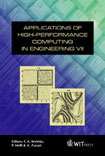Evaluation And Benchmark Of High-performance Computer Platforms For Automotive Crashworthiness Simulation
Price
Free (open access)
Volume
27
Pages
Published
2002
Size
611 kb
Paper DOI
10.2495/HPC020051
Copyright
WIT Press
Author(s)
C. –D. Kan, A. Eskandarian & J. Mader
Abstract
Evaluation and benchmark of high- performance computer platforms for automotive crashworthiness simulation C. -D. Kan, A. Eskandarian, & J. Mader FHWA/NHTSA National Crash Analysis Center, George Washington University, Virginia Campus, 201 01 Academic Way, Ashburn, Virginia 20147, USA Abstract This paper reports the evaluation and benchmark results of vehicle crash simulations using high-performance computer systems, which is well suited for addressing some of the above-mentioned computational and user requirements. In this paper, two large size vehicle models are used in this benchmark study for a typical industrial standard crashworthiness application. The performance related issue including parallelism, reliability, and repeatability of the simulation results are addressed. The results of porting of MPP version of the commercial crash code, LS-DYNA, are also included in this paper. Introduction Today, computer simulations using finite element (FE) methods are routinely used by engineers for virtually all modes of crashworthiness related analyses, ranging from vehicle structural design, occupant protection assessment, as well as roadside hardware evaluation. At the same time, the size and complexity of finite element models used in these simulations has been increased exponentially over the past five years. In order to have reasonable turn-around time to solve crash models, it requires availability of high-performance computer platforms that are low-cost and easy to use [1-71]. While traditional vector supercomputer architectures have continued to improve in performance, the growth in the performance of microprocessors has proceeded at a far more rapid rate. The price-performance ratio of vector supercomputers lags far behind than that of today’s microprocessor machines. However, individual microprocessors do not
Keywords




